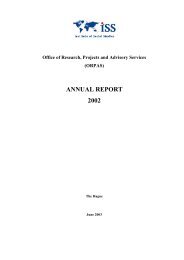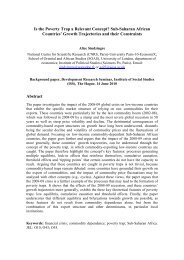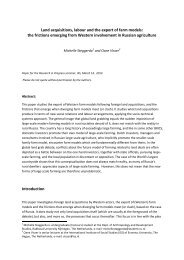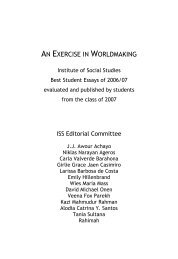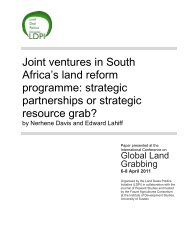AN EXERCISE IN WORLDMAKING 2009 - ISS
AN EXERCISE IN WORLDMAKING 2009 - ISS
AN EXERCISE IN WORLDMAKING 2009 - ISS
Create successful ePaper yourself
Turn your PDF publications into a flip-book with our unique Google optimized e-Paper software.
194 TARA TABASSI<br />
ments, undermine her and generate a feeble, pathetic character. Is Gula<br />
presented as anything more than nothing? The narrative continues<br />
brightly, ‘The two younger daughters still have a chance.’ If they have a<br />
chance at the light Gula has supposedly missed, the assumption is that<br />
something must occur so as to remedy this lack. And quickly….<br />
5. Result/Resolution: Reunion of Survivor and Saviour!<br />
The result/resolution clause releases tensions in the narrative and finally<br />
tells what happened (Johnstone 2001:638). ‘The reunion between the<br />
woman with the green eyes and the photographer was quiet.’ This is justified<br />
through cultural explanations, ‘[for] married women, cultural tradition<br />
is strict. She must not look [and]… smile - at a man who is not her<br />
husband.’ Repetitively the article continues, ‘she did not smile at<br />
McCurry’ as if to imply unfriendliness to him, despite earlier explanations.<br />
Gula’s thoughts are constructed, ‘she cannot understand how her<br />
picture has touched so many. She does not know the power of those<br />
eyes.’ Gula has become multi-layered in her ignorance: she cannot perceive<br />
what all in the West know of her: the power of ‘those’ eyes.<br />
6. Coda: She survived?<br />
The story closes with the Coda, whereby summaries or brief connection<br />
with the world is achieved (Johnstone 2001:638) and concludes with her<br />
Survivor role. ‘Such knife-thin odds. That she would be alive. That she<br />
could be found. That she could endure such loss.’ Repetitious sentence<br />
structure emphasizes the gravity. ‘Knife’ imagery implies danger and recalls<br />
her ethnically-violent inherency. The pairing of the dehumanising<br />
‘found’ and dangerous imagery implies courage of those who find her.<br />
The righteous conclusion that ‘surely, in the face of such bitterness<br />
the spirit could atrophy,’ comparing what could have happened, suggests<br />
that Gula’s spirit has indeed atrophied. Reference is made to Gula’s<br />
‘losses,’ not mentioned before except of one daughter’s death. Gula is<br />
asked: ‘How had she survived?’ Such a grand question fails to take into<br />
account her point of reference, as if her survival was nearly impossible,<br />
despite the survival of millions of Afghani refugees. ‘The answer came<br />
wrapped in unshakable certitude. “It was,” said Sharbat Gula, “the will<br />
of God”.’ This is one of few times Gula’s full name is used instead of<br />
female pronouns or only first name, reinforcing diminutive objectification.<br />
The choice of ‘unshakable certitude’ suggests fanatical faith, and is




